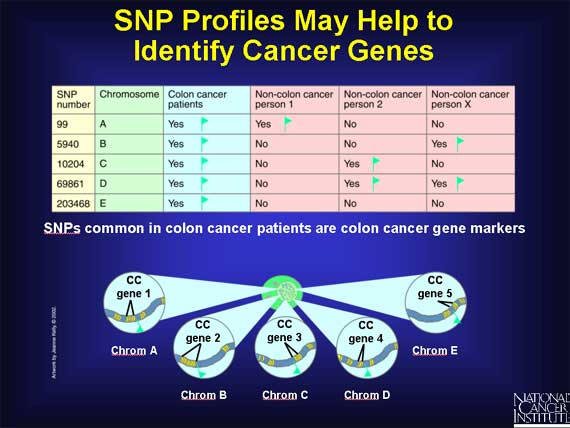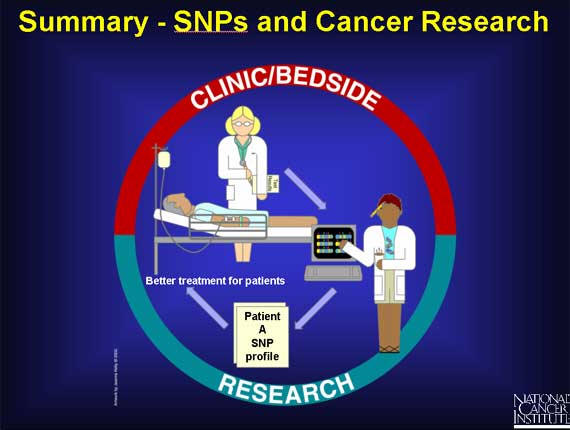34

SNPs may also explain why some patients respond well to a specific drug treatment, while others have minimal or no response. SNPs may also be involved when patients have different side effects in response to the same drug. Many proteins interact with the drug - involved in its transportation throughout the body, absorption into tissues, metabolism into more active forms or toxic by-products, and excretion. If a patient has SNPs in any one or more of these proteins, they may alter the time the body is exposed to active forms of the drug or any of its toxic byproducts.
35

SNPs are very common variations scattered throughout the genome. Because they are fairly easy to measure and are also remarkably stable, being inherited from generation to generation, they have become useful as gene "markers." If a particular SNP is located near a gene, then every time that gene is passed from parent to child, the SNP is passed on also. This enables researchers to assume that when they find the same SNP in a group of individual genomes, the associated gene is present also.
36

Scientists are trying to identify all the different SNPs in the human genome. They are sequencing the genomes of a large number of people and then comparing the base sequences to discover SNPs. The sequence data is being stored in computers that can generate a single map of the human genome containing all possible SNPs.
37

The genome of each individual contains its own pattern of SNPs. Thus, each individual has his or her own SNP profile. When scientists look at all the patterns from a large number of people they can organize them into groups.
38

Doctors hope that by studying SNP profiles in populations, correlations will emerge between certain SNP profiles and specific responses to cancer treatment. In the earlier example of two breast cancer patients, one did respond to the specific drug treatment, and the other did not. It may soon be possible to show that an entire group of patients responding well to breast cancer treatment repeatedly display profiles within a recurring set (e.g., A and E), while a group of non-responders repeatedly display profiles outside the set. In the future, after a doctor has diagnosed breast cancer in a new patient, he may also request a SNP profile and use the information to help advise his patient about her treatment options.
39

Since SNPs can be gene markers, SNP profiles may help scientists to identify the full collection of genes that contribute to the development of complex diseases such as cancer. For example, scientists will examine the SNP profiles from many people, including colon cancer patients. Within the many different profiles they may discover a small subset of SNPs that are only present in colon cancer patients. This implies that this subset of SNPs is associated only with colon cancer. When this happens, the SNPs themselves may be considered markers for colon cancer genes.
40

Scientists are also using SNPs to calculate risk factors associated with cancer in large populations. First, imagine analyzing the SNPs in a random population of 100 people. 80 percent are found to have SNP A and the remaining 20 percent have SNP B. Now look at another 100 people, all with kidney cancer. In this group, 60 percent have SNP A and 40 percent have SNP B. Neither SNP A nor SNP B causes cancer. However, from this data, physicians can say that a person who has SNP B is at a higher risk for kidney cancer than a person with SNP A.
41

Armed with data from the SNP Map, cancer researchers across the country are looking for correlations between SNPs and precancerous conditions, SNPs and drug resistance in chemotherapy, SNPs and cancer susceptibility, and SNPs and drug response. There is much work ahead, but there is also much hope that these and other research findings will result in improved health care for all.